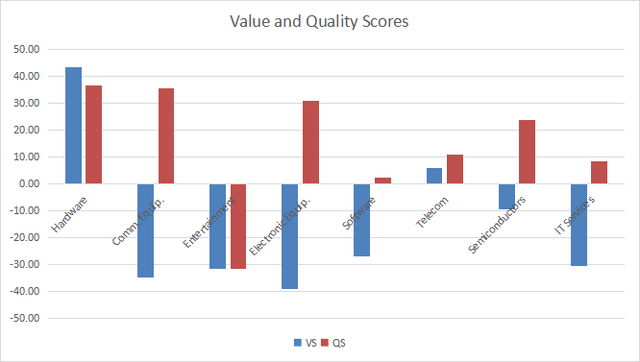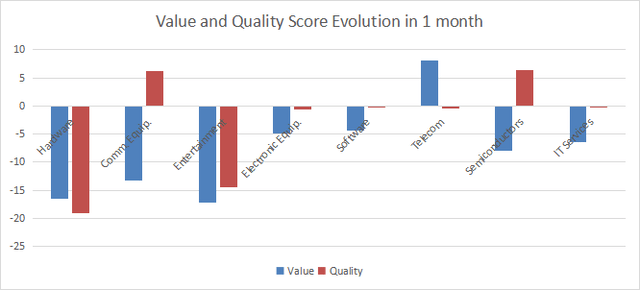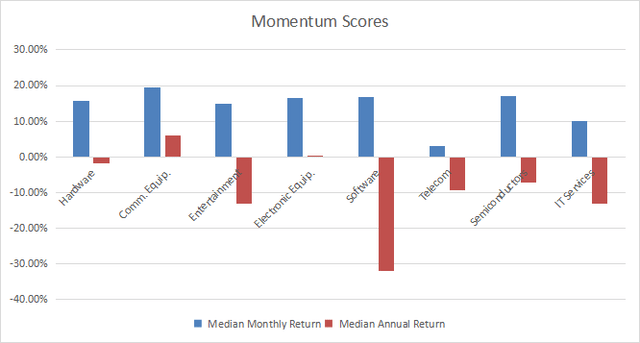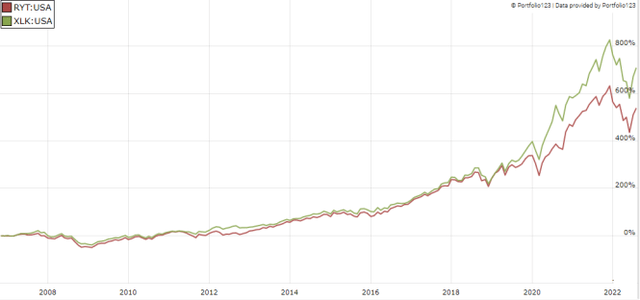piranka
This monthly article series shows a dashboard with aggregate industry metrics in technology and communication services. It may also serve as a top-down analysis of some technology ETFs, whose largest holdings are used to calculate these metrics.
Shortcut
The next two paragraphs in italic describe the dashboard methodology. They are necessary for new readers to understand the metrics. If you are used to this series or if you are short of time, you can skip them and go to the charts.
Base Metrics
I calculate the median value of five fundamental ratios for each industry: Earnings Yield (“EY”), Sales Yield (“SY”), Free Cash Flow Yield (“FY”), Return on Equity (“ROE”), Gross Margin (“GM”). The reference universe includes large companies in the U.S. stock market. The five base metrics are calculated on trailing 12 months. For all of them, higher is better. EY, SY and FY are medians of the inverse of Price/Earnings, Price/Sales and Price/Free Cash Flow. They are better for statistical studies than price-to-something ratios, which are unusable or non available when the “something” is close to zero or negative (for example, companies with negative earnings). I also look at two momentum metrics for each group: the median monthly return (RetM) and the median annual return (RetY).
I prefer medians to averages because a median splits a set in a good half and a bad half. A capital-weighted average is skewed by extreme values and the largest companies. My metrics are designed for stock-picking rather than index investing.
Value and Quality Scores
I calculate historical baselines for all metrics. They are noted respectively EYh, SYh, FYh, ROEh, GMh, and they are calculated as the averages on a look-back period of 11 years. For example, the value of EYh for hardware in the table below is the 11-year average of the median Earnings Yield in hardware companies.
The Value Score (“VS”) is defined as the average difference in % between the three valuation ratios (EY, SY, FY) and their baselines (EYh, SYh, FYh). The same way, the Quality Score (“QS”) is the average difference between the two quality ratios (ROE, GM) and their baselines (ROEh, GMh).
The scores are in percentage points. VS may be interpreted as the percentage of undervaluation or overvaluation relative to the baseline (positive is good, negative is bad). This interpretation must be taken with caution: the baseline is an arbitrary reference, not a supposed fair value. The formula assumes that the three valuation metrics are of equal importance.
Current data
The next table shows the metrics and scores as of last week’s closing. Columns stand for all the data named and defined above.
|
VS |
QS |
EY |
SY |
FY |
ROE |
GM |
EYh |
SYh |
FYh |
ROEh |
GMh |
RetM |
RetY |
|
|
Hardware |
43.53 |
36.77 |
0.0679 |
1.2895 |
0.0402 |
13.08 |
39.51 |
0.0355 |
0.9175 |
0.0407 |
7.30 |
41.80 |
15.63% |
-1.77% |
|
Comm. Equip. |
-34.69 |
35.53 |
0.0271 |
0.1385 |
0.0251 |
26.87 |
61.85 |
0.0315 |
0.2802 |
0.0415 |
15.43 |
63.82 |
19.42% |
6.00% |
|
Entertainment |
-31.66 |
-31.43 |
0.0142 |
0.4969 |
0.0245 |
6.23 |
45.78 |
0.0499 |
0.4394 |
0.0386 |
17.30 |
45.27 |
14.75% |
-13.17% |
|
Electronic Equip. |
-39.04 |
31.12 |
0.0360 |
0.3879 |
0.0212 |
18.25 |
42.65 |
0.0436 |
0.8221 |
0.0399 |
12.87 |
35.42 |
16.61% |
0.33% |
|
Software |
-26.80 |
2.47 |
0.0233 |
0.1239 |
0.0241 |
18.94 |
83.78 |
0.0273 |
0.1762 |
0.0377 |
17.60 |
86.09 |
16.77% |
-32.01% |
|
Telecom |
6.12 |
10.93 |
0.0766 |
0.7080 |
0.0154 |
14.65 |
57.47 |
0.0496 |
0.6489 |
0.0281 |
11.83 |
58.66 |
2.95% |
-9.33% |
|
Semiconductors |
-9.53 |
23.92 |
0.0518 |
0.2158 |
0.0268 |
34.59 |
62.57 |
0.0468 |
0.2501 |
0.0360 |
23.49 |
62.20 |
16.94% |
-7.27% |
|
IT Services |
-30.59 |
8.63 |
0.0322 |
0.1881 |
0.0230 |
30.07 |
54.59 |
0.0389 |
0.3349 |
0.0332 |
25.24 |
55.62 |
10.13% |
-13.12% |
Value And Quality chart
The next chart plots the Value and Quality Scores by industry (higher is better).
Value and Quality in technology (chart: author; data: Portfolio123)
Evolution since last month
The value score has improved in telecommunication and deteriorated elsewhere. The quality score has improved in communication equipment and semiconductors, and deteriorated in hardware and entertainment.
Score variations (chart: author; data: Portfolio123)
Momentum
The next chart plots momentum data.
Momentum in technology (Chart: author; data: Portfolio123)
Interpretation
Hardware is the top-ranked technology industry regarding both value and quality scores. It is followed by telecommunication, undervalued by 6% relative to 11-year averages and standing above the quality baseline. Other industries are overvalued by 9% to 39%. Good quality scores may partly justify overvaluation in communication equipment, electronic equipment and semiconductors. Entertainment is the less attractive industry in regard to my metrics: both value and quality are far below the baseline.
Fast facts on RYT
The Invesco S&P 500 Equal Weight Technology ETF (NYSEARCA:RYT) has been tracking the S&P 500 Equal Weight Information Technology Index since 11/01/2006. It has a total expense ratio of 0.40%, which is significantly more expensive than capital-weighted ETFs in the same sector like XLK and VGT (0.10%). As of writing, the fund holds 77 stocks. Holdings are in equal weight on every rebalancing, but they may drift with price action. The next table shows the top 10 holdings with basic valuation and growth metrics. Their aggregate weight is 15.6%. The largest holding weighs less than 2% of the portfolio value. The risk related to individual stocks is much lower than for capital weighted ETFs in the sector, where the top two holdings Apple Inc. (AAPL) and Microsoft Corp. (MSFT) together represent over about 45% of asset value.
|
Ticker |
Name |
Weight% |
EPS growth %TTM |
P/E TTM |
P/E fwd |
Yield% |
|
Arista Networks Inc. |
1.57 |
41.68 |
40.01 |
32.37 |
0 |
|
|
Broadridge Financial Solutions Inc. |
1.47 |
-2.01 |
38.99 |
25.14 |
1.64 |
|
|
Ceridian HCM Holding Inc. |
1.55 |
-20.56 |
N/A |
119.53 |
0 |
|
|
Cadence Design Systems Inc. |
1.50 |
15.34 |
68.87 |
46.64 |
0 |
|
|
Enphase Energy Inc. |
1.78 |
12.78 |
204.04 |
72.13 |
0 |
|
|
EPAM Systems Inc. |
1.71 |
-8.66 |
72.27 |
45.32 |
0 |
|
|
Intuit Inc. |
1.49 |
12.87 |
55.37 |
41.64 |
0.56 |
|
|
Paycom Software Inc. |
1.57 |
35.45 |
101.15 |
68.99 |
0 |
|
|
PayPal Holdings Inc. |
1.48 |
-57.68 |
58.91 |
26.00 |
0 |
|
|
Synopsys Inc. |
1.48 |
24.81 |
59.99 |
44.92 |
0 |
Data calculated with Portfolio123
RYT has lagged XLK since inception (November 2006): 541% vs. 726% in total return. This is a difference of about 1.8 percentage point annualized. Despite a lower idiosyncratic risk (exposure to individual stocks), RYT shows a higher risk than XLK measured in historical volatility and drawdowns.
|
Total Return |
Annual. Return |
Drawdown |
Sharpe |
Volatility |
|
|
RYT |
541.19% |
12.50% |
-59.23% |
0.63 |
20.22% |
|
XLK |
725.51% |
14.32% |
-52.80% |
0.75 |
18.65% |
RYT was on par with XLK until 2019, then it started lagging it:
In summary, RYT is a good instrument for investors seeking a technology fund without excessive exposure to big tech companies. However, the theoretical edge of an equal-weight strategy has been underwhelming for 15 years: it is significantly inferior to capital-weighted technology ETFs in risk-adjusted performance since inception. Moreover, management fees are higher.
Dashboard List
I use the first table to calculate value and quality scores. It may also be used in a stock-picking process to check how companies stand among their peers. For example, the EY column tells us that a hardware company with an earnings yield above 0.0679 (or price/earnings below 14.73) is in the better half of the industry regarding this metric. A Dashboard List is sent every month to Quantitative Risk & Value subscribers with the most profitable companies standing in the better half among their peers regarding the three valuation metrics at the same time. The list below was sent to subscribers several weeks ago based on data available at this time.
|
Thryv Holdings Inc. |
|
|
Ziff Davis Inc. |
|
|
Kulicke and Soffa Industries Inc. |
|
|
Alpha and Omega Semiconductor Limited |
|
|
ON Semiconductor Corp. |
|
|
Teradata Corporation |
|
|
Citrix Systems Inc. |
It is a rotating list with a statistical bias toward excess returns on the long-term, not the result of an analysis of each stock.



Be the first to comment